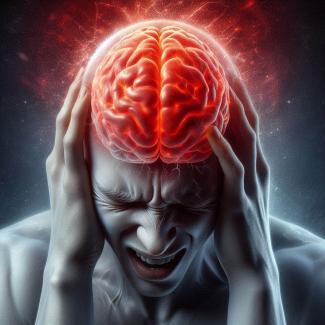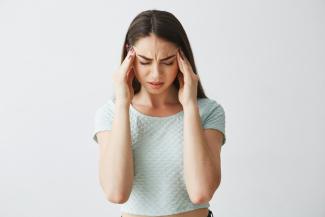
Headaches are among the most common ailments experienced by people worldwide. They can vary greatly in their intensity, duration, and underlying causes. While most headaches are not a sign of a serious illness, some can indicate more severe health issues that require medical attention. Understanding the types, causes, and treatments of headaches is essential for managing and alleviating their impact on daily life. This comprehensive guide will explore the most common headache problems, their causes, symptoms, and potential treatments.
Types of Headaches
Headaches can be broadly categorized into primary and secondary headaches. Primary headaches are not caused by another medical condition, whereas secondary headaches are symptomatic of an underlying health issue.
1. Tension Headaches
Tension headaches are the most common type of primary headache. They are often described as a constant pressure or tightness, typically around the forehead, temples, or back of the head and neck. The pain can range from mild to moderate and usually affects both sides of the head.
Causes:
- Stress: Emotional stress is a significant trigger for tension headaches.
- Muscle tension: Poor posture, eye strain, and muscle tension in the neck and shoulders can lead to these headaches.
- Dehydration: Insufficient fluid intake can contribute to the development of tension headaches.
- Lack of sleep: Inadequate or poor-quality sleep can be a trigger.
Symptoms:
- Dull, aching head pain
- Sensation of tightness or pressure across the forehead or on the sides and back of the head
- Tenderness on the scalp, neck, and shoulder muscles
2. Migraines
Migraines are a type of primary headache characterized by intense, throbbing pain, often on one side of the head. They are frequently accompanied by other symptoms such as nausea, vomiting, and sensitivity to light and sound. Migraines can last from a few hours to several days and can significantly impact daily activities.
Causes:
- Genetics: Family history plays a role in migraines.
- Hormonal changes: Fluctuations in hormones, especially in women, can trigger migraines.
- Environmental factors: Changes in weather, strong smells, or loud noises can trigger migraines.
- Dietary triggers: Certain foods and drinks, such as aged cheeses, alcohol, and caffeine, can provoke migraines.
Symptoms:
- Severe, throbbing pain usually on one side of the head
- Nausea and vomiting
- Sensitivity to light, sound, and sometimes smell and touch
- Aura: Some people experience visual disturbances or other neurological symptoms before or during a migraine.
3. Cluster Headaches
Cluster headaches are a less common but extremely severe type of primary headache. They occur in cyclical patterns or clusters, often waking individuals from sleep with intense pain concentrated around one eye or one side of the head. These headaches can last from 15 minutes to three hours and may occur multiple times a day during a cluster period.
Causes:
- The exact cause is unknown, but abnormalities in the hypothalamus might play a role.
- Possible triggers include alcohol, strong smells, and changes in sleep patterns.
Symptoms:
- Excruciating pain around one eye or one side of the head
- Redness and tearing in the affected eye
- Stuffy or runny nose
- Sweating and facial flushing on the affected side
4. Sinus Headaches
Sinus headaches are secondary headaches caused by inflammation and congestion of the sinuses, typically due to infection or allergies. The pain is often localized around the forehead, cheeks, and nose.
Causes:
- Sinusitis: Inflammation or infection of the sinuses.
- Allergies: Allergic reactions can cause sinus inflammation.
- Nasal polyps: Growths in the nasal passages can block sinuses.
Symptoms:
- Deep, constant pain in the cheekbones, forehead, or bridge of the nose
- Pain intensifies with sudden head movements or straining
- Nasal discharge
- Fever and facial swelling in severe cases
5. Rebound Headaches
Rebound headaches, also known as medication-overuse headaches, occur from the frequent use of headache medications. They are typically characterized by a pattern of daily or almost daily headaches.
Causes:
- Overuse of pain relief medications such as aspirin, acetaminophen, ibuprofen, and prescription drugs like triptans and opioids.
Symptoms:
- Persistent, dull headache
- Often worse upon waking
- Relief with medication, but pain returns as the medication wears off
6. Thunderclap Headaches
Thunderclap headaches are severe headaches that come on suddenly and reach peak intensity within 60 seconds. They can be a symptom of serious underlying conditions such as a subarachnoid hemorrhage, stroke, or aneurysm.
Causes:
- Subarachnoid hemorrhage: Bleeding in the brain.
- Cerebral venous thrombosis: Blood clot in the brain's venous system.
- Hypertensive crisis: Sudden, severe increase in blood pressure.
Symptoms:
- Sudden, severe headache
- May be accompanied by nausea, vomiting, or loss of consciousness
- Neurological symptoms like weakness, confusion, or speech difficulties
Diagnosis of Headaches
Diagnosing the type and cause of a headache involves a thorough medical history, physical examination, and sometimes additional tests.
Medical History:
- Frequency, duration, and intensity of headaches
- Location and character of pain
- Associated symptoms (e.g., nausea, aura)
- Family history of headaches or migraines
- Medication use
Physical Examination:
- Neurological examination to check for signs of brain and nervous system problems
- Inspection for signs of infection or other physical abnormalities
Additional Tests:
- Imaging studies: MRI or CT scans can detect abnormalities in the brain.
- Blood tests: Can identify underlying conditions like infections or metabolic disorders.
- Lumbar puncture: Analysis of cerebrospinal fluid can help diagnose infections or bleeding in the brain.
Treatment of Headaches
Treatment strategies for headaches depend on the type and cause of the headache. They can include lifestyle changes, medication, and alternative therapies.
Lifestyle Changes
- Regular Exercise: Helps reduce stress and improve overall health, potentially reducing the frequency and severity of headaches.
- Adequate Hydration: Drinking enough water can prevent dehydration-induced headaches.
- Healthy Diet: Avoiding trigger foods and eating a balanced diet can help prevent headaches.
- Sleep Hygiene: Maintaining a regular sleep schedule and ensuring quality sleep can prevent headaches.
- Stress Management: Techniques such as yoga, meditation, and deep breathing exercises can help manage stress.
Medications
Over-the-Counter (OTC) Pain Relievers:
- Aspirin, ibuprofen, and acetaminophen can be effective for tension headaches and mild migraines.
Prescription Medications:
- Triptans: Specifically for migraines, they help relieve pain and other symptoms.
- Ergotamines: Effective for migraine treatment.
- Preventive Medications: Beta-blockers, antidepressants, and anticonvulsants can be used to prevent migraines.
Medications for Cluster Headaches:
- Oxygen therapy: Inhaling pure oxygen can reduce the severity and duration of cluster headaches.
- Triptans: Injectable or nasal spray forms are effective for cluster headaches.
Alternative Therapies
Acupuncture:
- Inserting thin needles into specific points on the body to relieve pain.
Massage Therapy:
- Helps reduce muscle tension and relieve headache pain.
Herbal Supplements:
- Butterbur and feverfew have been used to prevent migraines.
Biofeedback:
- Uses sensors to monitor physiological processes, helping patients learn to control bodily functions that can contribute to headaches.
Prevention of Headaches
Preventive strategies can significantly reduce the frequency and severity of headaches.
- Identifying and Avoiding Triggers:
- Keeping a headache diary can help identify specific triggers, such as certain foods, stress, or environmental factors.
- Regular Physical Activity:
- Engaging in regular exercise can help manage stress and improve overall health.
- Healthy Diet:
- Eating regular, balanced meals and avoiding trigger foods can prevent headaches.
- Adequate Sleep:
- Maintaining a regular sleep schedule and ensuring sufficient sleep can prevent headaches.
- Stress Management:
- Techniques like meditation, yoga, and deep breathing can help manage stress and prevent headaches.
Headaches are a widespread issue that can range from a minor inconvenience to a significant health problem. Understanding the different types of headaches, their causes, and potential treatments is crucial for effective management. While most headaches can be managed with lifestyle changes and over-the-counter medications, some require medical intervention. Identifying triggers and adopting preventive measures can significantly reduce the frequency and severity of headaches, improving overall quality of life. If you experience frequent, severe, or unusual headaches, it is essential to seek medical advice to rule out any serious underlying conditions.
How do I know if my headache is dangerous or just a headache that will go away?
Determining whether a headache is dangerous or benign can be challenging, but there are several signs and symptoms that can help you discern if medical attention is necessary. While most headaches are not serious, some can indicate underlying health issues that require prompt intervention. Here are some guidelines to help you assess your headache:
Warning Signs of a Dangerous Headache
- Sudden and Severe Onset
- A sudden, severe headache, often described as the "worst headache of my life," could be a sign of a subarachnoid hemorrhage or other serious conditions. This type of headache reaches maximum intensity within seconds to minutes.
- Headache with Neurological Symptoms
- If your headache is accompanied by symptoms such as confusion, difficulty speaking, vision changes, weakness, numbness, or difficulty walking, it could indicate a stroke or other neurological problem.
- Headache Following Head Injury
- A headache that develops after a head injury could be due to a concussion, brain hemorrhage, or other serious issues. This type of headache should always be evaluated by a healthcare professional.
- Headache with Fever and Stiff Neck
- A headache combined with a fever, stiff neck, and sensitivity to light could signal meningitis, an infection of the membranes surrounding the brain and spinal cord.
- Progressive Headache
- A headache that progressively worsens over days or weeks, or a headache that changes in pattern or intensity, might suggest a serious underlying condition, such as a brain tumor or an intracranial pressure problem.
- Headache with Seizures or Fainting
- If your headache is accompanied by seizures, fainting, or loss of consciousness, it requires immediate medical evaluation.
- Persistent Headache in Individuals with a History of Cancer
- For individuals with a history of cancer, a new or persistent headache could indicate metastasis to the brain and should be promptly assessed.
- Thunderclap Headache
- A thunderclap headache is a severe headache that peaks within 60 seconds. It could be caused by a subarachnoid hemorrhage, reversible cerebral vasoconstriction syndrome (RCVS), or other vascular problems.
- Headache with Altered Mental Status
- If your headache is accompanied by changes in mental status, such as confusion, drowsiness, or personality changes, it could be due to encephalitis, brain hemorrhage, or other serious conditions.
When to Seek Medical Attention
If you experience any of the above warning signs, it is crucial to seek medical attention immediately. Even if your headache does not fit these criteria but feels unusual or concerning to you, it is always best to consult with a healthcare professional for reassurance and proper diagnosis.
Common, Non-Dangerous Headaches
Most headaches are benign and can be managed with lifestyle changes, over-the-counter medications, and home remedies. Here are some common types of non-dangerous headaches and their characteristics:
- Tension Headaches
- These are the most common type of headache, characterized by a dull, aching pain around the forehead, temples, or back of the head. They are often triggered by stress, poor posture, or muscle tension.
- Migraines
- Migraines are intense headaches often accompanied by nausea, vomiting, and sensitivity to light and sound. They typically affect one side of the head and can last for hours to days. Migraines can be triggered by hormonal changes, certain foods, stress, and other factors.
- Cluster Headaches
- These are severe headaches that occur in cyclical patterns or clusters. They cause intense pain around one eye and can last from 15 minutes to three hours. They often occur at the same time each day during a cluster period.
- Sinus Headaches
- These headaches are caused by inflammation and congestion of the sinuses, typically due to infection or allergies. They cause deep, constant pain in the forehead, cheeks, and bridge of the nose.
- Rebound Headaches
- Also known as medication-overuse headaches, these occur from frequent use of headache medications. They often present as a persistent, dull headache that gets better with medication but returns as the medication wears off.
Steps to Manage Non-Dangerous Headaches
- Hydration
- Drink plenty of water to avoid dehydration, which can cause headaches.
- Rest
- Ensure you get adequate sleep and take breaks to rest if you feel a headache coming on.
- Stress Management
- Practice stress-reducing techniques such as deep breathing, yoga, or meditation.
- Proper Posture
- Maintain good posture, especially if you work at a desk or use electronic devices frequently.
- Diet and Nutrition
- Avoid foods and drinks that trigger your headaches. Eat regular, balanced meals to maintain stable blood sugar levels.
- Over-the-Counter Medications
- Use pain relievers such as acetaminophen, ibuprofen, or aspirin as directed for occasional headache relief.
- Cold or Warm Compress
- Apply a cold or warm compress to your head or neck to alleviate headache pain.
While most headaches are benign and can be managed with simple remedies, it is essential to be aware of the warning signs that indicate a potentially dangerous headache. If you experience sudden, severe headaches, headaches with neurological symptoms, or headaches following a head injury, seek medical attention immediately. For non-dangerous headaches, adopting healthy lifestyle habits and using over-the-counter medications can provide significant relief. Always consult with a healthcare professional if you have concerns about your headaches or if they change in pattern, frequency, or intensity.
How can I help relieve a headache with home natural remedies?
Relieving a headache with home natural remedies can be both effective and soothing. Here are several strategies that you can try to alleviate headache pain using natural methods:
1. Hydration
Drink Water:
- Dehydration is a common cause of headaches. Drinking enough water throughout the day can help prevent and relieve headaches. Aim for at least 8 glasses of water a day.
Electrolyte Drinks:
- Sometimes, headaches are due to an imbalance of electrolytes. Drinking coconut water or an electrolyte-replenishing drink can help restore balance.
2. Cold or Warm Compress
Cold Compress:
- Applying a cold compress to your forehead or the back of your neck can help reduce inflammation and numb the pain. Use a cold pack, a bag of frozen vegetables wrapped in a towel, or a cold, damp cloth.
Warm Compress:
- For tension headaches, applying a warm compress can help relax tense muscles. Use a heating pad, warm towel, or take a warm shower to relieve muscle tension.
3. Herbal Remedies
Peppermint Oil:
- Peppermint oil has menthol, which can help relax muscles and ease pain. Dilute a few drops of peppermint oil with a carrier oil like coconut oil and apply it to your temples and forehead.
Lavender Oil:
- Lavender oil is known for its calming properties. Inhaling lavender oil or applying diluted lavender oil to the temples can help reduce headache symptoms.
Ginger Tea:
- Ginger has anti-inflammatory properties and can help reduce headache severity. Make a ginger tea by boiling fresh ginger slices in water for 10 minutes. Drink it warm with a bit of honey.
Feverfew:
- Feverfew is a traditional herb used to prevent migraines. You can take feverfew supplements or drink feverfew tea to help reduce headache frequency and severity.
4. Acupressure and Massage
Acupressure:
- Applying pressure to specific points on the body can help relieve headaches. The LI4 point (located between the base of the thumb and index finger) is commonly used. Apply firm, circular pressure for a few minutes.
Massage:
- Massaging the temples, neck, and shoulders can help release tension and improve circulation. Use gentle, circular motions to massage these areas.
5. Relaxation Techniques
Deep Breathing:
- Deep breathing exercises can help reduce stress and tension, which are common headache triggers. Practice deep breathing by inhaling slowly through your nose, holding for a few seconds, and then exhaling slowly through your mouth.
Meditation:
- Mindfulness meditation can help reduce stress and prevent headaches. Spend a few minutes each day meditating in a quiet, comfortable space.
Yoga:
- Yoga combines physical postures, breathing exercises, and meditation. Certain yoga poses can help reduce muscle tension and improve blood circulation, potentially relieving headaches.
6. Dietary Adjustments
Magnesium:
- Magnesium deficiency is linked to headaches and migraines. Incorporate magnesium-rich foods into your diet, such as spinach, almonds, avocados, and bananas.
Avoid Triggers:
- Identify and avoid foods that trigger your headaches. Common triggers include caffeine, alcohol, chocolate, and processed foods.
7. Proper Sleep
Maintain a Regular Sleep Schedule:
- Irregular sleep patterns can trigger headaches. Aim for 7-9 hours of sleep each night and try to go to bed and wake up at the same time every day.
Create a Restful Environment:
- Ensure your sleeping environment is comfortable, dark, and quiet. Use earplugs or a white noise machine if necessary.
8. Hydration with Herbal Teas
Chamomile Tea:
- Chamomile tea has anti-inflammatory and calming properties. Drinking chamomile tea can help reduce stress and relax muscles.
Peppermint Tea:
- Peppermint tea can help relieve tension headaches due to its menthol content. Brew peppermint tea and drink it slowly.
9. Apple Cider Vinegar
Apple Cider Vinegar Steam:
- Inhaling steam infused with apple cider vinegar can help relieve sinus headaches. Boil water, add a few tablespoons of apple cider vinegar, and inhale the steam with a towel over your head.
10. Lifestyle Adjustments
Reduce Screen Time:
- Prolonged screen time can strain your eyes and lead to headaches. Take regular breaks from screens, and ensure your screen is at eye level to reduce neck strain.
Exercise Regularly:
- Regular physical activity can help reduce the frequency and severity of headaches. Aim for at least 30 minutes of moderate exercise most days of the week.
Practice Good Posture:
- Poor posture can lead to muscle tension and headaches. Be mindful of your posture when sitting and standing. Use ergonomic furniture if you work at a desk.
Using natural remedies to relieve headaches can be an effective and gentle way to manage pain. By staying hydrated, using herbal treatments, practicing relaxation techniques, and making lifestyle adjustments, you can alleviate headache symptoms and potentially prevent future occurrences. If you find that your headaches persist or worsen, it is essential to seek medical advice to rule out any underlying conditions.






